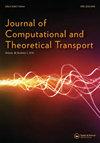A Response Matrix Method for Slab-Geometry Discrete Ordinates Adjoint Calculations in Energy-Dependent Neutral Particle Transport
IF 1.1
4区 工程技术
Q3 MATHEMATICS, APPLIED
Journal of Computational and Theoretical Transport
Pub Date : 2021-04-16
DOI:10.1080/23324309.2021.1914661
引用次数: 2
Abstract
Abstract Presented here is an application of the Response Matrix (RM ) method for adjoint discrete ordinates (S ) problems in slab-geometry applied to energy-dependent neutral particle transport problems. The RM method is free from spatial truncation errors, as it generates numerical results for the adjoint angular fluxes in multilayer slabs that agree with the numerical values obtained from the analytical solution of the energy multigroup adjoint S equations. The main contribution of this work is to analyze the application of the RM method to problems where it is required to solve the energy multigroup adjoint S equations multiple times. This is the case of two classes of problems that can be taken care of through the adjoint technique: (i) source-detector problems; and (ii) the estimation of interior neutron source distributions that drive a subcritical system at a prescribed power density level. The efficiency (speed and accuracy) of the RM code is compared to the conventional Diamond Difference code.能量相关中性粒子输运中板几何离散坐标伴随计算的响应矩阵方法
摘要本文介绍了响应矩阵(RM)方法在板几何中伴随离散坐标(S)问题中的应用,并应用于能量依赖的中性粒子输运问题。RM法得到的多层板的伴随角通量数值结果与能量多群伴随S方程解析解得到的数值吻合,不存在空间截断误差。本工作的主要贡献是分析了RM方法在需要多次求解能量多群伴随S方程的问题中的应用。这是可以通过伴随技术处理的两类问题的情况:(i)源检测器问题;(ii)在规定功率密度水平下驱动亚临界系统的内部中子源分布的估计。将RM码的效率(速度和精度)与传统的钻石差码进行了比较。
本文章由计算机程序翻译,如有差异,请以英文原文为准。
求助全文
约1分钟内获得全文
求助全文
来源期刊

Journal of Computational and Theoretical Transport
Mathematics-Mathematical Physics
CiteScore
1.30
自引率
0.00%
发文量
15
期刊介绍:
Emphasizing computational methods and theoretical studies, this unique journal invites articles on neutral-particle transport, kinetic theory, radiative transfer, charged-particle transport, and macroscopic transport phenomena. In addition, the journal encourages articles on uncertainty quantification related to these fields. Offering a range of information and research methodologies unavailable elsewhere, Journal of Computational and Theoretical Transport brings together closely related mathematical concepts and techniques to encourage a productive, interdisciplinary exchange of ideas.
 求助内容:
求助内容: 应助结果提醒方式:
应助结果提醒方式:


